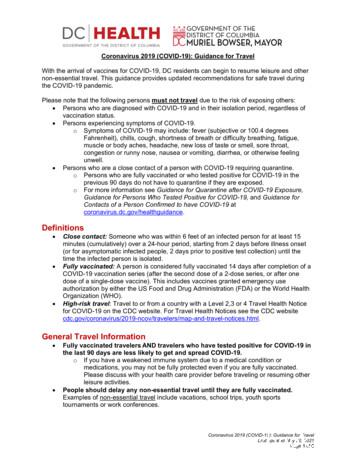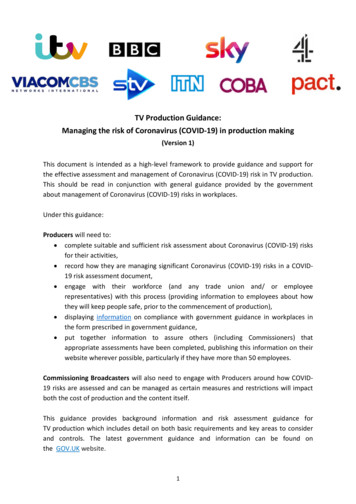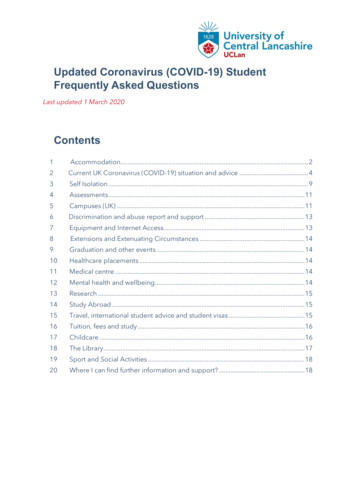Novel Coronavirus (COVID-19) Guidance For Active Screening .
Updated December 18, 2020Publication number 820-108Novel Coronavirus (COVID-19) Guidance forActive Screening of Employees at 24/7 StateOperated FacilitiesThe Washington State Department of Health has developed guidance to assist 24/7 stateoperated facilities in response to the 2019 novel coronavirus disease (COVID-19) outbreak. 24/7state-operated facilities include: veterans homes, correctional, behavioral health,developmental disability and juvenile rehabilitation facilities. While operating in compliancewith other applicable law, these facilities will modify processes to come into compliance withthese protocols and will communicate agency process changes to staff and others. 24/7 stateoperated facilities have experience managing respiratory infection outbreaks among residents,and staff should at a minimum apply the same outbreak management principles to COVID-19.Additionally, facilities should actively screen employees to prevent resident and staff exposureto COVID-19.Stay Up-to-dateMonitor public health updates from: Local Public Health DepartmentWashington State Department of HealthCenters for Disease Control and Prevention Situation SummaryEmployee Screening 24/7 state-operated facilities will conduct active screening of all employees to preventresident and staff exposure to COVID-19. Agencies will operate in compliance with DOH guidelines. Signs should be posted at building entrances and in reception areas alerting employeesto active screening protocols, including: o Temperature information or temperature check, depending on the facilityo Standard questions about symptoms consistent with COVID-19Additionally, visible signage should educate employees about COVID-19 and theimportance of practicing infection prevention and control measures, including:o Frequent handwashing or, if a sink is not readily available, use of alcohol-basedhand sanitizero Appropriate use of personal protective equipment (PPE)o Sneezing/coughing into a tissue or elbow
o Putting used tissues in a plastic-lined waste receptacle and washing handsimmediately aftero Avoiding handshakeso See CDC Print Resources for posters to printActive Screening of Employees Active screening must take place each time an employee reports to work. Employees should be directed to specified checkpoints for active screening. Screening will be performed by staff who have been trained on the screening protocol. Active screening consists of temperature information and a standardized questionnaire.Facilities may use their discretion in allowing staff to provide this information.o When temperature checks are performed, a device that has been approvedfor use by each facility will be used. Staff should refer to the instructions on the packaging or themanufacturer’s website for guidance on how to properly take anemployee’s temperature, as steps vary by brand and model. The employee screening questionnaire includes the following questions: Since your last day of work, have you had any of these symptoms that youcannot attribute to another condition? Fever or chillsCoughShortness of breath or difficulty breathingFatigueMuscle or body achesHeadacheNew loss of taste or smellSore throatCongestionNausea or vomitingDiarrhea2. Within the last 14 days, have you had close contact or direct contact, without theuse of appropriate PPE, with someone who is currently sick with suspected orconfirmed COVID-19? Note: This means having direct contact with infectiousfluids from the person (for example, being coughed or sneezed on; and closecontact is defined as someone who was within 6 feet of the person for acumulative total of 15 minutes or more within a 24 hour period (this includeswhen people are wearing face coverings).Criteria for Screening Out an Employee If an employee has a temperature greater than or equal to 100.4 , entry to the facilitywill be denied.2
If an employee answers “yes” to having new onset of any symptoms other than fever(temperature greater than or equal to 100.4 ), entry to the facility will be denied andthe employee will be referred for secondary screening. If an employee has had close contact with someone who has confirmed or suspectedCOVID-19 and is asymptomatic, they should be excluded from work for 14 days from thelast exposure unless they are able to return to work sooner based on the criteriaoutlined below in “Employees Who Have Been Screened Out.”Secondary Screening The purpose of secondary screening is to determine employee fitness for duty based onestablished protocols.Ideally, secondary screening should be performed by staff who have medical training ora background in infection control procedures.Secondary screening will be performed as soon as possible, preferably before sendingthe employee home, based on the availability of staff trained on the secondaryscreening protocol.Secondary screenings must be documented and maintained.Employees who pass secondary screening must be actively screened each time theyreport to work.Criteria for Passing Secondary Screening Employees who meet all three of the following criteria: 1) 10 days since symptoms firstappeared, 2) 24 hours with no fever (defined as temperature greater than or equal to100.4 ) without the use of fever-reducing medication, and 3) COVID-19 symptoms (e.g.,cough, shortness of breath) have improved. *Loss of taste and smell may persist forweeks or months after recovery and need not delay the end of isolation.o Exception: Employees returning after a severe case of COVID-19, or employeeswho are severely immunocompromised and returning after a confirmed case ofCOVID-19, may need to isolate longer than 10 days and up to 20 days, asrecommended by a healthcare provider or infection control expert. Refer to theCDC’s return to work guidelines, adopted by DOH, for more information. Employees who 1) self-disclose that their symptoms are related to a health conditionother than COVID-19, such as allergies or asthma, and do not feel sick, and 2) have nothad close contact with a confirmed case of COVID-19, unless there are other concerninghealth-related matters. Based on the judgment of the medical and/or infection control staff performingsecondary screening, facilities may exercise discretion in allowing an employee with asymptom that is not attributed to another health condition, such as headache, to enterthe facility, as long as 1) the employee does not have other concerning symptoms, 2)the employee has not had close contact with a confirmed case of COVID-19, and 3) the3
severity of the symptom is not serious enough to prevent the employee fromperforming their job duties. Employees will be cleared for work when:o The employee passed their secondary screening immediately after their initialactive screening.o The secondary screening is passed by phone consultation after the employeewent home, and the employee does not have a temperature greater than orequal to 100.4 or any new relevant symptoms on return to work.Employees Who Have Been Screened Out For employees with confirmed COVID-19, refer to the CDC’s return to work guidance,adopted by DOH.For asymptomatic employees who have had close contact with someone who hasconfirmed or suspected COVID-19:o Ideally, these employees should be excluded from work for 14 days from the lastexposure. This is the safest option.o If a 14-day quarantine is not possible due to critical staffing constraints, afterconsultation with DOH and/or the local health jurisdiction, facilities can considerimplementing the following acceptable alternatives as outlined in DOH’squarantine guidance. Employees quarantine for 10 days after last contact, without additionaltesting. If any COVID-19 symptoms develop within the 10-day period,employees must remain in quarantine for the full 14 days and get tested.Employees must self-monitor for symptoms until day 14. Under special circumstances, it may be possible to end quarantine after 7full days after the last contact AND after receiving a negative COVID-19test taken no sooner than 48 hours before ending quarantine. This willdepend on availability of testing resources. Employees must self-monitorfor symptoms until day 14.o Facilities facing a severe staffing shortage, where the above options are notfeasible, may consult with DOH and/or the local health jurisdiction on allowingasymptomatic employees who have had close contact to continue workingwithout a quarantine period. Under these circumstances, employees mustadhere to the following protocols for 14 days from the last exposure: Actively monitor for symptoms consistent with COVID-19, and ifsymptoms develop, immediately cease work, notify their supervisor andself-isolate.Adhere to cough etiquette and hand hygiene.Wear a facemask at all times while in the facility.For additional information, refer to the CDC’s guidance on mitigatinghealthcare personnel staffing shortages, adopted by DOH.4
For symptomatic employees with no known exposure to COVID-19, refer to DOH’sguidance on infection prevention, home isolation and when to contact a healthcareprovider. All employees must be actively screened upon their return to work. Refer to State HR’s Guidance for Supervisors for more information on how to answeremployee questions related to COVID-19 and how to determine pay and leave status foremployees who have been screened out.More COVID-19 Information and ResourcesStay up-to-date on the current COVID-19 situation in Washington, Governor Inslee’sproclamations, symptoms, how it spreads, and how and when people should get tested. Seeour Frequently Asked Questions for more information.A person’s race/ethnicity or nationality does not, itself, put them at greater risk of COVID-19.However, data are revealing that communities of color are being disproportionately impactedby COVID-19- this is due to the effects of racism, and in particular, structural racism, that leavessome groups with fewer opportunities to protect themselves and their communities. Stigmawill not help to fight the illness. Share accurate information with others to keep rumors andmisinformation from spreading. WA State Department of Health 2019 Novel Coronavirus Outbreak (COVID-19)WA State Coronavirus Response (COVID-19)Find Your Local Health Department or DistrictCDC Coronavirus (COVID-19)Stigma Reduction ResourcesHave more questions about COVID-19? Call our hotline: 1-800-525-0127, Monday – Friday, 6a.m. to 10 p.m., Weekends: 8 a.m. to 6 p.m. For interpretative services, press # when theyanswer and say your language. For questions about your own health, COVID-19 testing, ortesting results, please contact a health care provider.To request this document in another format, call 1-800-525-0127. Deaf or hard of hearingcustomers, please call 711 (Washington Relay) or email civil.rights@doh.wa.gov.5
The Washington State Department of Health has developed guidance to assist 24/7 state-operated facilities in response to the 2019 novel coronavirus disease (COVID-19) outbreak. 24/7 state-operated facilities include: veterans homes, correctional, behavioral health, developmental disability and juvenile rehabilitation facilities.
May 17, 2021 · Coronavirus 2019 (COVID-19): Guidance for Travel Last updated May 18, 2021 Page 1 of 6. Coronavirus 2019 (COVID-19): Guidance for Travel . With the arrival of vaccines for COVID-19, DC residents can begin to resume leisure and other non-essential travel. This guidance provides updated reco
May 19, 2021 · Coronavirus 2019 (COVID-19): Guidance for Travel Last updated May 20, 2021 Page 1 of 6 Coronavirus 2019 (COVID-19): Guidance for Travel With the arrival of vaccines for COVID-19, DC residents can begin to resume leisure and other non-essential travel. This guidance provides updated recommendations for s
Managing the risk of Coronavirus (COVID-19) in production making (Version 1) This document is intended as a highlevel framework to provide guidance and support for - the effective assessment and management of Coronavirus (COVID19) risk in TV production. - This should be read in conjunction with general guidance provided by the government about management of Coronavirus (COVID-19) risks in .
What is Novel Coronavirus COVID-19? Novel Coronavirus COVID-19 is a new strain of coronavirus that can cause respiratory infections in humans. It was first identified in December 2019 in China and has spread rapidly around the world. In humans, several coronaviruses are known to cause respiratory infections ranging from the common cold to more severe diseases.
2 Current UK Coronavirus (COVID-19) situation and advice What is the current UK situation regarding Coronavirus? The current coronavirus alert level in the UK is 4, which means Covid-19 is in general circulation, transmission is high or rising and current social distancing measures and restrictions are in place. From 5 January 2021 the Government imposed a national lockdown. This means .
Questions fréquentes : COVID-19 et tuberculose Version 2, 22 avril 2020. Cette version remplace toutes les autres versions. Le nouveau coronavirus ou coronavirus 2 du syndrome respiratoire aigu sévère (SARS-CoV-2) est un nouveau coronavirus récemment découvert en 2019. Le virus est à l'origine de la maladie à coronavirus 2019 (COVID-19).
Website: www.moh.gov.jm COVID-19 PREPAREDNESS AND RESPONSE PLAN FOR OUTBREAK CONTROL CLINICAL MANAGEMENT OF SEVERE ACUTE RESPIRATORY INFECTION WHEN NOVEL CORONAVIRUS COVID-19 INFECTION IS SUSPECTED March 2020 –Version 2 BACKGROUND This clinical guidance for novel coronavirus, is an adaptation of World Health
Reading Practice Test, a practice opportunity for the Nebraska State Accountability (NeSA). Each question will ask you to select an answer from among four choices. For all questions: † Read each passage. Then answer each question carefully by choosing the best answer. † Mark your answers for ALL of the questions. Remember only one of the choices provided is the correct answer. SP10R08XP01 .























